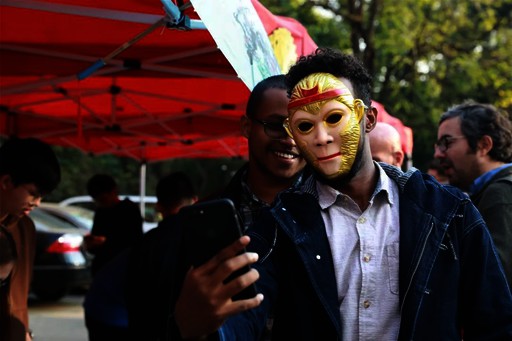
. > WHAT'S NEW > RESEARCH
Scholars call for dialogue to deal with cultural misreading
Author : DUAN DANJIE Source : Chinese Social Sciences Today 2020-07-13

Encouraging active dialogue is an effective way of reducing cultural misreading in the process of China-foreign cultural exchange. Photo: HHU
The international influence of Chinese culture continues to increase amid the process of globalization. However, differences with Western cultures have caused Chinese culture to encounter different levels of cultural misreading. How should people correctly understand the phenomenon of cultural misreading and the causes behind it?
The process of cross-cultural communication easily generates cultural misreading, due to differences in languages, cultures, concepts and ways of thinking. With the rise of hermeneutics and reception theory, people have gradually discarded the traditional view that misreading merely refers to incorrect interpretation. They have realized that misreading is a phenomenon formed in the process of communication with other cultures, a deviation from an original meaning to varying degrees when understanding heterogeneous cultures based on one’s own cultural tradition. In addition to cultural differences, unfamiliarity with heterogeneous cultures is another important factor that leads to misreading, said Ding Guoqi, deputy director of the Institute of Literature at the Chinese Academy of Social Sciences.
Misreading is an inevitable result and a widespread phenomenon of cultural exchange and collision, said by Fu Shouxiang, a professor from the School of Humanities at Wenzhou University. Fu said that translation is an important factor behind the generation and deepening of misreading. Languages are deeply rooted in the history and culture behind them, and it is almost impossible to achieve absolute equivalence in translation. People from different cultural backgrounds tend to hold different views of life, values and outlooks on the world. Even if they address the same subject or text, they may have a completely different understanding.
“Cultural misreading is a typical issue when people from different cultures communicate with each other,” said Wang Daqiao, a professor from the School of Chinese Language and Literature at Lanzhou University. Without sufficient dialogue with other cultures, cultural misinterpretation is very likely to occur in the process of Chinese culture’s “going global” which involves the traditional lifestyles of the Chinese people, Wang added.
Fan Daqi, an associate research fellow from the Academy of Contemporary China and World Studies at China Foreign Languages Publishing Administration, said that any culture is gradually nurtured and developed after a long period of social development. Both Chinese and Western cultures have experienced thousands of years of development. As two cultures that have bred in different environments, their collision will inevitably lead to misreading.
With increasing international exchange, cultural misreading has become a hot topic. Ding observed that people usually stand in their respective positions in China-West cultural exchange, and they may easily misread their heterogeneous cultures if they do not fully understand each other. Even so, misreading can also create a certain positive effect. Misreading that promotes communication and integration between different cultures is creative misreading. Each culture is unique. We can innovate with our own cultural traditions on the basis of fully understanding heterogeneous cultures. This will help reduce communication barriers, promote mutual understanding, and facilitate the innovation, creativity and prosperity of respective cultures.
Irrational attitudes such as underestimating or overestimating the value of heterogeneous cultures will make it difficult to effectively promote China-foreign cultural exchange. In order to reduce cultural misreading, an objective and unbiased attitude is needed to view the differences inherent in people’s perspectives and emotional experiences in different cultural contexts, and to understand people’s feelings within a particular culture, Wang added.
Fu said that avoiding misreading is vital for promoting cross-cultural communication. People of different cultural backgrounds should communicate with more open, inclusive, equal and respectful attitudes, reducing cultural misinterpretation through understanding and dialogue. Meanwhile, in terms of unavoidable cultural misreading, people should respect cultural differences, actively and equally initiate dialogue with others, and reflect on their own national cultures for better development.
Cultural misreading is a complex cognitive issue that should be addressed dialectically to avoid the development of cultural misreading into cultural conflict. While firmly upholding self-confidence in culture, we should also adopt an open and positive attitude to understand and communicate with other cultures and deal with cultural differences with broader minds. Achieving the exchange and integration of Chinese and Western cultures under the principle of “harmony in diversity” is the way to deal with cultural misreading, Ding concluded.
Ye Shengtao made Chinese fairy tales from a wilderness
Ye Shengtao (1894–1988) created the first collection of fairy tales in the history of Chinese children’s literature...
-
How northern ethnicities integrated into Chinese nation
2023-09-18
-
Mogao caves
2023-09-12
-
Mogao Grottoes as ‘a place of pilgrimage’
2023-09-12
-
Time-honored architectural traditions in China
2023-08-29
-
Disentangling the civilizational evolution of China
2023-08-28
-
AI ethics in science fiction
2023-08-23













 2011-2013 by www.cssn.cn. All Rights Reserved
2011-2013 by www.cssn.cn. All Rights Reserved